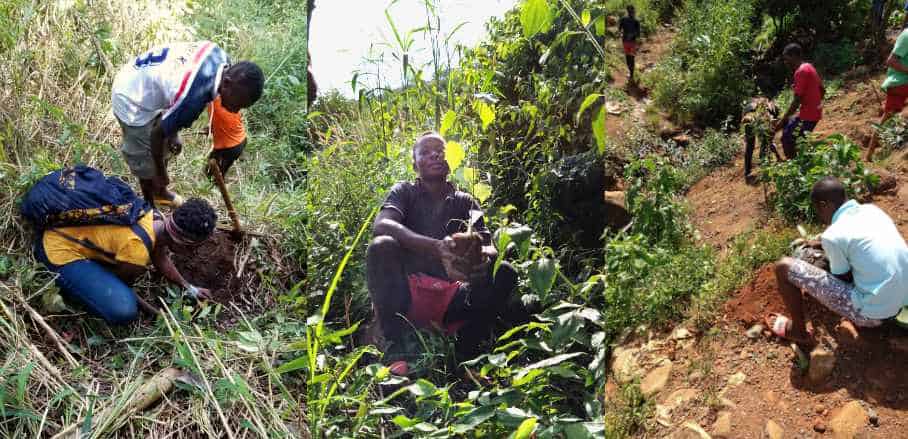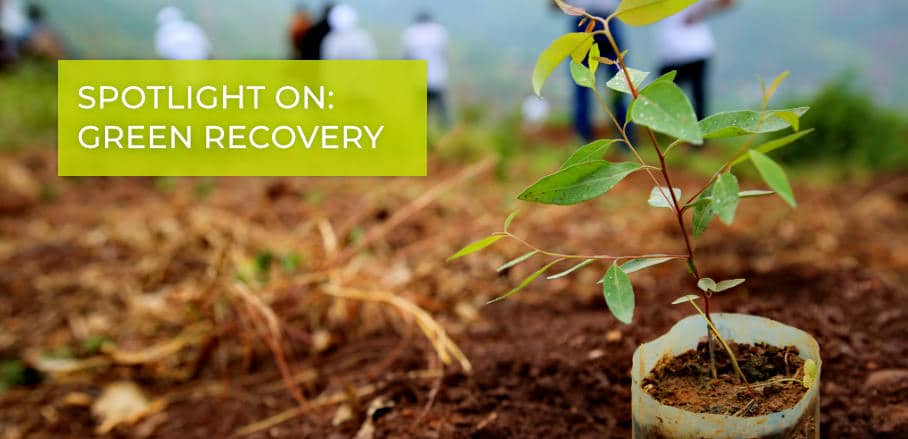Empowering Young People to Contribute to Freetown’s Green Recovery
Davephine Tholley on how planting trees in Sierra Leone’s capital Freetown contributes to the country’s environmental sustainability and socio-economic development.
Sierra Leone is a beautiful country, but our forests are being cut down massively to serve agriculture, logging, mining, and the building sector. Deforestation has a lot of effects on our people, animals, and the environment. These include its contribution to global warming, flooding, soil erosion – and the spread of zoonotic diseases. This is because animals who serve as hosts for viruses are forced to move out of these forests and interact with more humans when their habitats are destroyed as a result of deforestation.
Another effect of deforestation is the drying-up of water sources. I was part of a water catchment area assessment by the National Water Resources Management Agency around the Freetown Peninsula, and we found that most water catchment areas have undergone massive deforestation due to building activities, agriculture, and logging. This has reduced the water sources’ capacity to retain their capacity to supply good quality water all year round. Activities like stone mining further decrease water quality. All of this has contributed to creating dry zones all over Freetown.
Therefore, planting trees is a promising approach to reviving our ecosystems and thereby contributing to a healthy environment – and the healthier our environment, the healthier its people. This is one reason why, especially after a pandemic like COVID-19, green recovery is so important.
#TransformFreetown
The Mayor of Freetown, Yvonne Aki-Sawyerr, is on a bid to #TransformFreetown by planting one million trees – to help mitigate climate change, protect the environment, and create jobs. From the Tree Planting Project Phase 1, conducted as a community-based stewardship model to plant, track, and grow trees, more than 550 green jobs were created in Freetown during the COVID-19 pandemic. Most of the growers in the participating communities were young people, and also some partnering community-based organisations were led by youngsters. Love to see it!

Planting trees with the Deep Eye Water community © Davephine Ayesatta Tholley
The water catchment area assessment prioritised the areas Gloucester Saddle and Deep Eye Water as most in need of reforestation measures. As a Freetown Women4Climate mentee, my project was to reforest a water catchment area, under the guidance of my mentor, Mrs Cleopatra Warritay. A contact introduced me to the stakeholders in the Deep Eye Water community in early 2020. During our meetings we talked about the consequences of their activities to the water sources, why they needed to reforest, and what they needed to do to protect the newly planted trees.
The community mentioned water scarcity, claiming that the source had not been able to serve them as it used to before. It turns out that, to aid stone mining, people had been cutting down trees and also burning the pipes by lighting fires too close to them. Most people do not realise they are destroying the environment by such behaviour. However, they were very enthusiastic about the idea to plant trees – this is why working with the communities is so important. We have to spread knowledge about the causal relations between human action, environmental degradations, and the decrease of resources and livelihoods.
Communities Taking Ownership
Through the Mayor’s Tree Planting Project, we could get 500 trees for the community and through community engagement, we were able to maximise participation in all the reforestation decision-making and distributed the task of planting exercise within the community. Consequently, the community took ownership of the reforestation of their water catchment area.
Further, the councillor of the Deep Eyer Water community arranged for the seedlings to be transported into the planting area. The community was very cooperative and coordinated the nearly 25 volunteers. Together, we planted about 350 trees in the catchment area and distributed the rest throughout the community. Also, 10 volunteers from the community opted to be part of the monitoring team, to make sure the majority of the trees survived.
Currently, we are implementing a six-month monitoring plan that will allow us to replicate this process in other communities with water catchment areas. From my last visit, some of the trees were destroyed because of a fire set near them, but the rest were thriving. With the community taking ownership, it made collaboration easy. The people took responsibility even though they did not receive any compensation. Also, they did a demarcation and promised to enforce it at the community level with fines levied on defaulters.

Empowering young people in Freetown © Davephine Ayesatta Tholley
How to Further Advance Green Recovery in Sierra Leone?
In Sierra Leone, we have many communities and regions that are developing, but they are doing so haphazardly, with many of them lacking access to clean water, electricity, and basic sanitary facilities. These communities offer great potential to both contribute to and benefit from green recovery measures – but their potential is yet untapped.
Some measures can be implemented as an individual, such as to not litter, conserve water, conserve energy, and properly dispose of waste. But others, such as implementing sustainable waste management, green agriculture, planting trees and creating green spaces, and access to renewable energy are capital-intensive. Scaling green recovery interventions requires financial and in-kind resources.
This is especially true for those most vulnerable during a crisis: young people, especially young girls and women. We have to make sure that they are at the table, contributing to policies and implementing initiatives that contribute to green recovery. With limited resources, there is only so much we can do as young people, and most times we do not have the vote of confidence or are not trusted to have the capacity to implement interventions. Nevertheless, through this project, I got young people involved in community tree planting and growing at the Deep Eye Water community. Certainly, this will also have a cascading effect in other communities, where people will teach their families, friends and surrounding about preserving the environment.
In summary, to advance green recovery, solutions need to be inclusive. They need to involve young and old, women and men, government, businesses, and community-based organisations!
